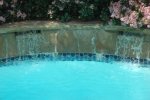CYA is sold as stabilizer. You're going to have to look at the ingredients on the container. What you want is as close to 100% cyanuric acid as you can get.
Use the pool calculator (link in my signature line) to determine how much to add to your pool If your current CYA is 25, you would want to bring it up to 40. Plug the number of gallons in your pool into the "gallons" field at the top of the calculator page, then scroll down to find the CYA section. Put 25 in the left box and 40 in the right box. That you tell you how much to add.
To add CYA, you can simply put some in a sock and hang it in front of a return. You can also put it in your skimmer. If you put it in your skimmer, you don't want to backwash for a few days or you'll lose it. CYA can take up to a week to dissolve. Don't recheck for CYA for at least a week after adding it.
You may just have to gently scrape at the scale. Mine comes back every year in that same spot and just yesterday, I removed it for the season. I brushed it with the MA and water solution, rinsed it well, and then got in there with a little putty knife to scrape what was left from the rock and tile. After the MA/water treatment, it gets pretty soft and so is easier to remove at that point. Just be careful. You don't want to remove more than you bargained for.


